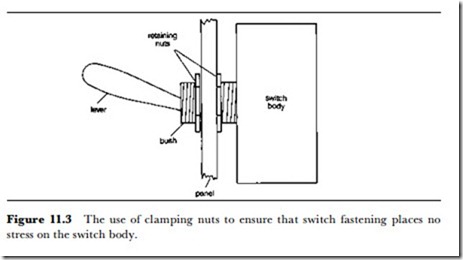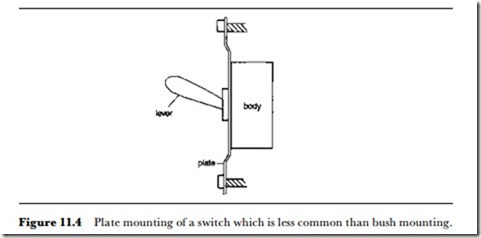Toggle switches
The toggle switch accounts for the majority of switch sales, and is available in the largest range of current and voltage ratings for electronics use. In addition to the large range of electrical characteristics, toggle switches are also available in a very wide variety of mechanical styles of mounting and actuation. The most common mounting method is the traditional threaded bush, generally of 0.468 inch diameter (ll.9 mm) and l0-ll mm length. The bush uses two clamping nuts so that the body of the switch need not be placed hard against the panel on which it is mounted (Figure ll.3). Both clamping nuts should always be used, because it is bad practice to butt the switch body against a panel with a single retaining nut on the other side. The use of bush mounting allows the switch to be mounted in
any position on a panel, but the conventional position allows the toggle to be operated in a vertical plane. Alternative mountings include plate mounting, in which the body of the switch at the toggle end is extended into a plate (Figure ll.4) which is drilled for fitting to a panel, and PCB mounting, in which the switch terminals are pins that will fit on a 0.linch (2.5 mm) grid. Since toggle switches for PCB mounting cannot be rotated relative to the printed board, such switches are available in vertical or horizontal toggle movement styles. Toggle switches for PCB mounting can also be obtained with plain (non-threaded) bushes for push-fitting through panels.
The actuating toggle itself can be obtained in a variety of lengths, and in rounded or paddle (spade) shapes. A long paddle-shaped toggle can often be an advantage for operating a switch that has a high spring pressure, and can also be easier to operate in an emergency than a short, round toggle. Coloured covers can be obtained for some round-toggle types, allowing for faster identification of switches. Some types can also be obtained with locking lever action to prevent casual or accidental switching. To operate such a switch, the toggle must be pulled out slightly against the tension of a spring before the switch-over movement can be made. Vaterproof sealing glands are available for some sizes, and PVC splash covers are also available for a lesser degree of protection. Connections are made by all the available methods of solder tags or buckets, screw fittings, PCB pins, and slide-on receptacles.
The contact materials for toggle switches will normally be silver-plated nickel, although the smaller switch sizes may allow a choice of solid silver or gold-plated contacts.

